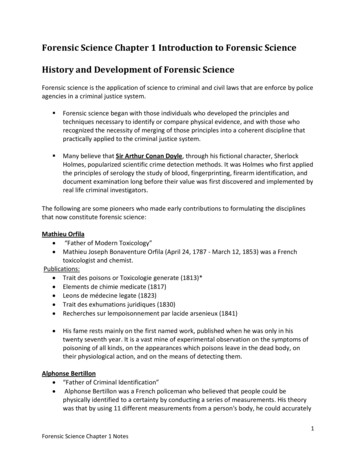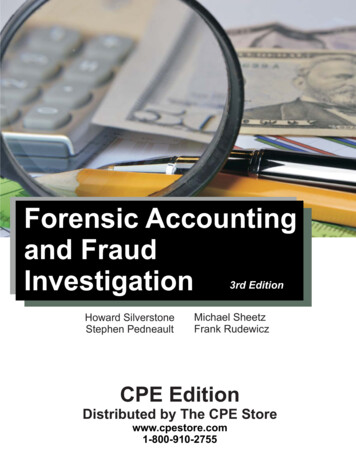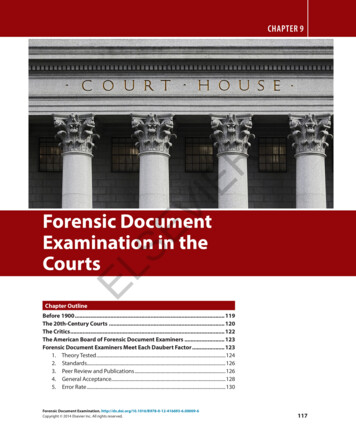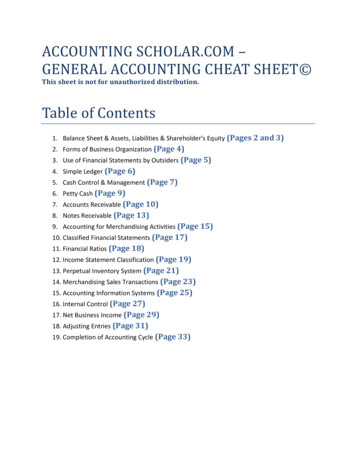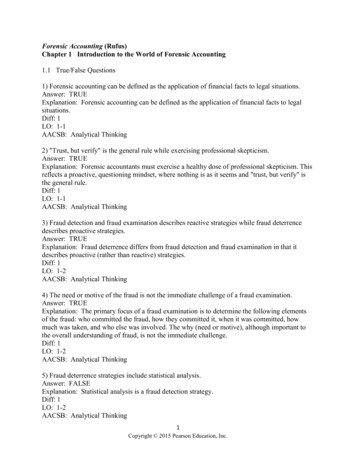
Transcription
Forensic Accounting (Rufus)Chapter 1 Introduction to the World of Forensic Accounting1.1 True/False Questions1) Forensic accounting can be defined as the application of financial facts to legal situations.Answer: TRUEExplanation: Forensic accounting can be defined as the application of financial facts to legalsituations.Diff: 1LO: 1-1AACSB: Analytical Thinking2) "Trust, but verify" is the general rule while exercising professional skepticism.Answer: TRUEExplanation: Forensic accountants must exercise a healthy dose of professional skepticism. Thisreflects a proactive, questioning mindset, where nothing is as it seems and "trust, but verify" isthe general rule.Diff: 1LO: 1-1AACSB: Analytical Thinking3) Fraud detection and fraud examination describes reactive strategies while fraud deterrencedescribes proactive strategies.Answer: TRUEExplanation: Fraud deterrence differs from fraud detection and fraud examination in that itdescribes proactive (rather than reactive) strategies.Diff: 1LO: 1-2AACSB: Analytical Thinking4) The need or motive of the fraud is not the immediate challenge of a fraud examination.Answer: TRUEExplanation: The primary focus of a fraud examination is to determine the following elementsof the fraud: who committed the fraud, how they committed it, when it was committed, howmuch was taken, and who else was involved. The why (need or motive), although important tothe overall understanding of fraud, is not the immediate challenge.Diff: 1LO: 1-2AACSB: Analytical Thinking5) Fraud deterrence strategies include statistical analysis.Answer: FALSEExplanation: Statistical analysis is a fraud detection strategy.Diff: 1LO: 1-2AACSB: Analytical Thinking1Copyright 2015 Pearson Education, Inc.
6) Fact witnesses can express opinions but expert witnesses cannot.Answer: FALSEExplanation: Expert witnesses differ from fact witnesses in that they can express opinions.Diff: 1LO: 1-2AACSB: Analytical Thinking7) The accounting process has three basic steps: recording, classifying, and summarizing.Answer: TRUEExplanation: The accounting process has three basic steps: recording, classifying, andsummarizing.Diff: 1LO: 1-3AACSB: Analytical Thinking8) The first line of defense against accounting failures within an organization is the externalauditor.Answer: FALSEExplanation: The first line of defense against accounting failures within an organization is theinternal auditor.Diff: 1LO: 1-3AACSB: Analytical Thinking9) Deductive reasoning draws conclusions from patterns.Answer: FALSEExplanation: Inductive reasoning draws conclusions from patterns.Diff: 1LO: 1-4AACSB: Analytical Thinking10) Expert reports prepared in the course of litigation are exempt from professional reportwriting standards.Answer: TRUEExplanation: Expert reports prepared in the course of litigation are exempt from professionalreport writing standards.Diff: 1LO: 1-4AACSB: Analytical Thinking2Copyright 2015 Pearson Education, Inc.
1.2 Multiple-Choice Questions1) Which of the following best describes the term forensic accounting?A) It is a discipline that deals with the preparation and analysis of financial statements ofcompanies.B) It is the use of accounting principles to consolidate financial statements of foreigncorporations.C) It is a discipline that primarily deals with methods of preparation of financial budgets of acompany.D) It is the use of accounting theories, principles, or analyses in a legal action, often throughexpert witness testimony.Answer: DExplanation: D) Forensic accounting can be defined as the use of accounting theories,principles, or analyses in a legal action, often through expert witness testimony. In other words,it is the application of financial facts to legal situations.Diff: 2LO: 1-1AACSB: Analytical Thinking2) Which of the following is recognized as the first forensic accountant?A) Frank J. WilsonB) Maurice PeloubetC) Alphonse CaponeD) Leslie A. ShuwayAnswer: AExplanation: A) The term forensic accountant was first used by Maurice Peloubet in 1946 in theJournal of Accountancy to recognize and celebrate IRS Special Agent Frank J. Wilson as theman who brought down Capone.Diff: 1LO: 1-1AACSB: Analytical Thinking3) Which of the following statement is true of forensic accountants?A) They should have a reactive mindset.B) They should focus their investigations on numbers rather than looking beyond them.C) They should embrace systematic thinking.D) They must trust their preexisting judgments.Answer: CExplanation: C) Forensic accountants need to be intellectually curious. In addition to this, theymust embrace systematic thinking and exercise a healthy dose of professional skepticism.Diff: 1LO: 1-1AACSB: Analytical Thinking3Copyright 2015 Pearson Education, Inc.
4) Which of the following shows Paul, a forensic accountant, indicating an intellectually curiousmindset?A) He relies on the reports given by the management to form an opinion on the financial viabilityof the business.B) He bases his judgments on the existing industry standards and not on the environment inwhich the organization operates.C) He gives room for the possibility that mistakes maybe attributable to negligence.D) He questions his understanding of an issue, in spite of being an expert in the field.Answer: DExplanation: D) An intellectually curious individual possesses a restless mind-one that is neversatisfied with his or her understanding of an issue, regardless of experience and expertise.Moreover, forensic accountants must have the instinct to explore problems that challengeconventional wisdom.Diff: 2LO: 1-1AACSB: Reflective Thinking5) Which of the following situations shows Kelcie, a forensic accountant, exercising professionalskepticism?A) Kelcie argues that the immediate previous year's records serve as a better basis for theinvestigation than the earlier years.B) Kelcie believes that the reputation of the external auditor is an indicator of the reliability ofthe audit report.C) Kelcie believes in the phrase "guilty, until proved otherwise" and does not presume innocenceuntil she has reasonable doubt.D) Kelcie verifies the reports given by the internal auditor against available evidence beforeusing it in her reports.Answer: DExplanation: D) Forensic accountants must exercise a healthy dose of professional skepticism.This reflects a proactive, questioning mindset, where nothing is as it seems and "trust, but verify"is the general rule. Kelcie follows this general rule, which indicates professional skepticism.Diff: 2LO: 1-1AACSB: Reflective Thinking4Copyright 2015 Pearson Education, Inc.
6) Which of the following statements is true of forensic accounting investigative services?A) These are provided in connection with actual, pending, or potential legal or regulatoryproceedings-criminal or civil.B) These are only performed after a crime has occurred.C) These include fraud detection, fraud examination, and fraud deterrence.D) These generally involve actual or threatened litigation.Answer: CExplanation: C) Investigative services provided by forensic accountants are generally related tocorporate investigations, which are initiated for the purpose of protecting the organization and itsassets from internal or external threats.Diff: 2LO: 1-2AACSB: Analytical Thinking7) Which of the following is a technique of fraud detection?A) perception of detectionB) analysis of financial statementC) preemployment screeningD) evaluation of hiring practicesAnswer: BExplanation: B) Fraud detection includes a variety of strategies, such as internal controlprocedures, statistical analysis, financial statements analysis, and anonymous reporting channels(such as hotlines).Diff: 2LO: 1-2AACSB: Analytical Thinking8) Which of the following is NOT the primary focus of a fraud examination by a forensicaccountant?A) Who committed the fraud?B) How was the fraud committed?C) When was the fraud committed?D) Why was the fraud committed?Answer: DExplanation: D) The primary focus of a fraud examination is to determine the followingelements of the fraud: who committed the fraud, how they committed it (the fraud scheme),when it was committed (time frame and duration), how much was taken, and who else wasinvolved. The why (need or motive), although important to our overall understanding of fraud, isnot the immediate challenge.Diff: 2LO: 1-2AACSB: Analytical Thinking5Copyright 2015 Pearson Education, Inc.
9) Which of the following is a difference between fraud examination and fraud detection?A) Fraud examination is done before a fraud has been committed, whereas fraud detection isdone after a fraud has been committed.B) Fraud examination is the investigation specific allegations or suspicions of fraud, whereasfraud detection is the identification of an error or irregularity after it has occurred.C) Fraud examination focuses on the time and duration of the fraud, whereas fraud detectionfocuses on the need or motive of the fraud.D) Fraud examination adapts proactive strategies, whereas fraud detection adapts reactivestrategies.Answer: BExplanation: B) Fraud detection is simply the discovery of fraud. Detective procedures aredesigned to identify an error or irregularity after it has occurred. A fraud examination's purposeis to investigate specific allegations or suspicions of fraud.Diff: 2LO: 1-2AACSB: Analytical Thinking10) Which of the following is most likely a short-term strategy for fraud deterrence?A) financial statement analysisB) employee invigilationC) time series analysisD) evaluation of hiring practicesAnswer: DExplanation: D) Examples of short-term (or procedural) strategies include evaluation of hiringpractices, internal controls, and performance monitoring.Diff: 1LO: 1-2AACSB: Analytical Thinking11) Which of the following is a proactive employee strategy of fraud deterrence?A) perception of detectionB) analysis of financial statementC) analysis of statistical dataD) employee contractsAnswer: AExplanation: A) Proactive employee strategies include preemployment screening, employeetraining, employee monitoring, perception of detection (through internal controls and externalaudits), and organizational culture.Diff: 2LO: 1-2AACSB: Analytical Thinking6Copyright 2015 Pearson Education, Inc.
12) Which of the following forensic accounting services primarily focuses on determining whocommitted the fraud, the scheme of the fraud, the time frame and duration, how much was taken,and who else was involved?A) fraud detectionB) fraud deterrenceC) fraud examinationD) fraud anticipationAnswer: CExplanation: C) The primary focus of a fraud examination is to determine the followingelements of the fraud: who committed the fraud, how they committed it (the fraud scheme),when it was committed (time frame and duration), how much was taken, and who else wasinvolved.Diff: 2LO: 1-2AACSB: Reflective Thinking13) Which of the following forensic accounting investigation services includes proactiveemployee strategies such as preemployment screening, employee training, and employeemonitoring strategies?A) fraud detectionB) fraud deterrenceC) fraud examinationD) fraud anticipationAnswer: BExplanation: B) Because fraud requires individual actors (the offenders), a reasonable startingpoint for fraud deterrence is employee relations. Proactive employee strategies includepreemployment screening, employee training, employee monitoring, perception of detection(through internal controls and external audits), and organizational culture.Diff: 2LO: 1-2AACSB: Reflective Thinking14) Which of the following best describes a whistle blower complaint?A) It is an informal disclosure of personal issues of an employee with other employees within anorganization.B) It is a disclosure by a person of wrong doing or misconduct within an organization.C) It is an annual complaint forum designed to discuss issues of an organization.D) It is a complaint raised by the SEC toward an organization.Answer: BExplanation: B) A whistleblower complaint is a disclosure by a person (usually an employee) ofwrongdoing or misconduct within the organization.Diff: 2LO: 1-2AACSB: Analytical Thinking7Copyright 2015 Pearson Education, Inc.
15) Which of the following is the most significant practice component of forensic accounting Asindicated by the results of a 2011 AICPA survey?A) bankruptcyB) business valuationsC) insolvency and reorganizationD) computer forensic analysisAnswer: BExplanation: B) The results of a 2011 American Institute of Certified Public Accountants surveyindicate that business valuations are by far the most significant practice component.Diff: 1LO: 1-2AACSB: Analytical Thinking16) Which of the following are the two major components of forensic accounting services?A) fraud detection services and fraud deterrence servicesB) expert services and consulting servicesC) investigative services and litigation servicesD) fraud examination services and business valuations servicesAnswer: CExplanation: C) Forensic accounting services are commonly divided into two majorcomponents: investigative services and litigation services.Diff: 1LO: 1-2AACSB: Analytical Thinking17) Which of the following is a difference between an external auditor and a forensicaccountant?A) An external auditor captures and records all economic transactions of the organization,whereas a forensic accountant ensures compliance with policy and procedures.B) An external auditor manages the organization's accounting and internal control system,whereas a forensic accountant validates effectiveness of controls in various processes or areas ofthe organization.C) An external auditor adds credibility to reported financial information, whereas a forensicaccountant provides assurance that management is adequately identifying and mitigating risks.D) An external auditor forms an opinion on the overall financial statements taken as a whole,whereas a forensic accountant addresses a specific question/issue.Answer: DExplanation: D) An external auditor forms an opinion on the overall financ
6) Which of the following statements is true of forensic accounting investigative services? A) These are provided in connection with actual, pending, or potential legal or regulatory proceedings-criminal or civil. B) These are only performed after a crime has occurred. C) These include fraud detection, fraud examination, and fraud deterrence.
